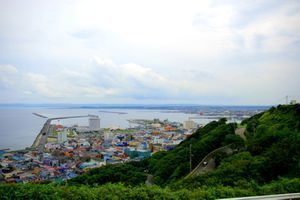Country Japan Prefecture Hokkaido - Flower Rosa rugosa Population 35,675 (30 Sep 2016) | Region Hokkaido - Tree Sakura, rowan Area 760.8 km² | |
 | ||
Time zone Japan Standard Time (UTC+9) Weather 3°C, Wind NW at 32 km/h, 77% Humidity Points of interest Cape Sōya, Noshappu Cape, Wakkanaifukko Market, Wakkanaishiritsunoshappukanryu Aquarium, Wakkanai Park | ||
Wakkanai (稚内市, Wakkanai-shi, Ainu: ヤㇺワッカナイ Yam-wakka-nay meaning "cold water river")) is a city located in Sōya Subprefecture, Hokkaido, Japan. It is the capital of Sōya Subprefecture and the northernmost city in Japan. It contains Japan's northernmost point, Cape Soya, from which the Russian island of Sakhalin can be seen.
Contents
- Map of Wakkanai Hokkaido Prefecture Japan
- History
- Geography
- Surrounding municipalities
- Climate
- Air
- Rail
- Sea
- University
- Public
- Private
- Tourist attractions
- Sister city
- Domestic
- International
- Sister ports
- References
Map of Wakkanai, Hokkaido Prefecture, Japan
As of October 2013, the city has an estimated population of 37,011 and a population density of 48.65 persons per km² (126 persons per mi²). The total area is 760.80 km2 (293.75 sq mi).
History
Wakkanai was originally home to an Ainu population. The first Japanese settlement was established in 1685.
During WWII: The Imperial Japanese Navy used the harbor and port as a submarine base. Wakkanai was far enough north to be outside the range of American heavy bombers and was safe from air attack. Until the early to mid-1960s, the northern portion of the harbor remained divided by concrete sub-mooring pens. The large breakwater structure (which still exists) was actually a sub-repair facility. At the shore end there was a huge winching mechanism capable of hauling subs up into the partially enclosed structure where they could be repaired while completely out of the water. Built into the hills above the city there were several reinforced concrete bunker-type caves where (anecdotally) they were used either to store ammunition and armament, or as air raid shelters for the civilian populace. History would suggest the former use, rather than the latter. During a re-build/renovation of the harbor sometime during the 1960s or 1970s, the harbor was cleared of the concrete pens and the machinery was removed from the breakwater structure which was reconfigured.
Geography
Cape Soya is located near Wakkanai, which is on a peninsula jutting towards Sakhalin. There is Benten-jima by northwest of Cape Soya.
Surrounding municipalities
Climate
Wakkanai has the typical humid continental climate (Köppen Dfb) of Hokkaido, with cold winters, warm summers and generally heavy precipitation from the Aleutian Low, whose winds hit the city direct from the Sea of Japan. The mean annual temperature, at 6.8 °C (44.2 °F), is the second lowest for a significant population centre in Japan after Nemuro. Snowfall at 6.6 metres (260 in), the third highest for a big city in Japan after Asahikawa and Aomori and one of the highest anywhere in the world. For comparison, Nain in Canada receives 194 inches (4.9 m) of snow.
The Aleutian Low also makes the sunshine hours the lowest of Japan's major population centres and in the winter the wind speeds are the highest in Japan with an average of 20.2 km/h (12.6 mph), which adds to the −4.7 °C (23.5 °F) cold of a typical winter day. The city's port is usually usable throughout the year, but does occasionally freeze in cold winters.
Air
Wakkanai Airport is located in Wakkanai.
Rail
JR Hokkaido runs a diesel train service on the Sōya Main Line from Asahikawa to Sapporo.
Sea
Heartland Ferry operates seasonal ferry service to Rebun-to and Rishiri-to. Ferry service to Korsakov on Sakhalin Island was terminated on September 18, 2015. Wakkanai governor KUDO Hiroshi has pledged to restore ferry service to Sakhalin, using city funds if necessary.
For the 2016 summer season, this route will be serviced by a high-speed catamaran ferry from Singapore named Penguin 33. The ferry is owned by Penguin International Limited and operated by Sakhalin Shipping Company.
University
Public
Private
Tourist attractions
The Daisuke Matsuzaka Museum, dedicated to the baseball pitcher "Dice-K" and opened in 2008, is located in Wakkanai, which is his father's hometown.
